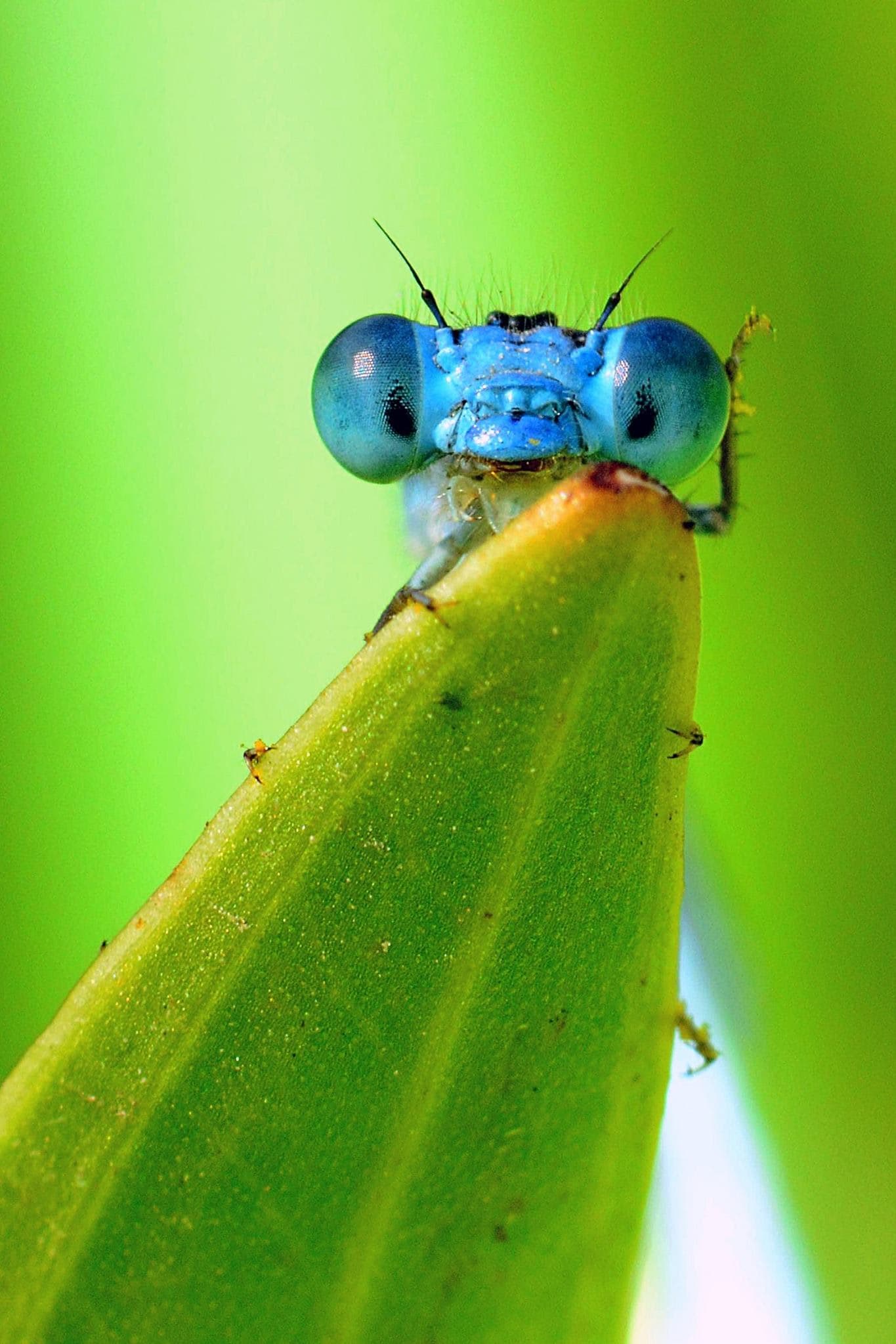 Listen to this article
•
15:34 min
Listen to this article
•
15:34 min
My tryst with damselflies began in early 2020. With a global pandemic in full spate and final exams pushed to the distant future, I patrolled my terrace and yard incessantly in search of worthy subjects for my camera. Early mornings were devoted to the koels, sunbirds, tailorbirds, and flamebacks that began their daily routines in the mango, coconut, and curry leaf trees near the house. As the warmth rose sharply with the sun, I could hear the classic “ki-kee” of the shikra and the whistle of the black kite as these raptors found thermals (rising columns of hot air) to ride to impossible heights. Meanwhile, the jumble of plants that took over the garden played host to creepy crawlies innumerate that I chased with my camera through the day with great enthusiasm.
Massive compound eyes, made up of thousands of ommatidia (clusters of light-receiving cells), are characteristic of damselflies. They give these insects the strong visual faculty they need to hunt prey midair. Photo: Ripan Biswas
Among these backyard critters was one that, on first impression, resembled a floating twig. A little over 3 cm long, the twig settled on the wall, and a pair of fine gossamer wings materialised, folding along its length. A quick photograph uploaded to iNaturalist (a citizen science app that helps people identify all things living) confirmed that it was a damselfly — a pygmy wisp (Agriocnemis pygmaea) to be specific. Thus began an obsession that kept me sufficiently occupied throughout lockdown.
Closely related to dragonflies, damselflies fall under the same order (Odonata); derived from the Greek word “odontos”, the name is a reference to the “toothed” nature of their mandibles or jaws. Typically smaller than dragonflies with more slender bodies, damselflies can be easily distinguished from them by their size and the position of their wings when at rest. Dragonflies usually spread out their wings, while damselfly wings are often closed along the length of their bodies. Their eyes are more wide-set than those of dragonflies, whose massive eyes appear to wrap around their heads.
Despite being weaker fliers than dragonflies, the courtship rituals of damselflies involve elaborate flight displays that, if successful, end with the pair mating in a distinct heart-shaped loop. The male is equipped with claspers on the last segments of his abdomen, which he uses to hold the female’s thorax. These clasps are uniquely matched for each species, a highly specific lock-and-key mechanism that prevents individuals of closely related species from mating with each other.
In one of the countless little marshes around Chennai, a pair of Coromandel marsh darts (Ceriagrion coromandelianum) seemingly float through the air in tandem, their translucent wings invisible in frenzied beating. They settle on the protruding shoot of a half-submerged plant; the male uses a harpoon-shaped structure in his accessory genitalia to remove sperm deposited in the female by other males! In the wild, improving your chances of passing on your genes means everything. A few minutes later, they unclasp one end of the loop, allowing the female to dip the end of her abdomen underwater.

The female makes fine incisions in the stem of the plant using her serrated ovipositor. Then she lays countless eggs inside, guarded throughout this process by her watchful mate. The larvae will soon hatch into the water — these skilled predators are capable of seizing prey either by stalking or waiting in ambush. As the larvae mature, they go through multiple rounds of moulting underwater until they crawl up into the terrestrial world for one final moult. Once above the surface, the adult damselfly slowly pulls itself out of its exuviae (old exoskeleton), fully develops its body, unfurls its wings, and dries them - a long-drawn process that prepares it for the remainder of its life in the outside world.
As their lives cycle through water, land, and air, damselflies face a range of threats to their survival at each stage. Their eggs play host to the eggs of smaller parasitic insects (of the order Hymenoptera), and the larvae of parasitic water mites (Hydrachnidia) feed on damselfly nymphs in the final stages of their development. Adult mites then attach themselves to the newly emerged damselfly as it leaves the water. Damselfly larvae also fall prey to frogs, fish, water spiders and other aquatic insects, while birds and even large dragonflies can catch the adults.
Besides the threats they face in the natural world, anthropogenic activities strongly impact the freshwater habitats around which the lives of these insects revolve. The concretisation of wetlands, damming of rivers and streams, and pollution through agricultural and industrial run-off take a severe toll on these ecosystems, manifested in part in the local disappearance of these odonates. As they act as crucial bioindicators (allow us to assess environmental health), observing and monitoring damselflies could, with time, provide keen insights into the health of freshwater ecosystems. And considering their whimsical appearances, impressive flight skills and fascinating life histories, the thought of observing them is hardly a dreary one.
Spotting these hovering needle-like insects can seem like an arduous task, but it soon becomes second nature to keep an eye out for them. From the bluetails and spreadwings in our garden to the stream rubies and yellow bush darts I’ve seen at college, damselflies have consistently held my attention, and I’m sure they will have no trouble holding yours either.
Photo sources: male pygmy wisp, female pygmy wisp, infestation with mite












